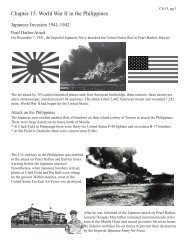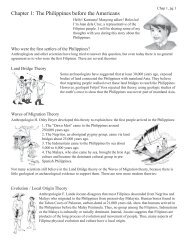Chapter 24: Carlos Garcia Era 1957-1961 - Chris Pforr Homepage
Chapter 24: Carlos Garcia Era 1957-1961 - Chris Pforr Homepage
Chapter 24: Carlos Garcia Era 1957-1961 - Chris Pforr Homepage
Create successful ePaper yourself
Turn your PDF publications into a flip-book with our unique Google optimized e-Paper software.
<strong>Chapter</strong> <strong>24</strong>: <strong>Carlos</strong> <strong>Garcia</strong> <strong>Era</strong> <strong>1957</strong>-<strong>1961</strong><br />
Pilipino Muna<br />
Chap 20, pg 1<br />
Vice-President <strong>Carlos</strong> P. <strong>Garcia</strong> succeeded to the presidency in March <strong>1957</strong> following the<br />
death of Ramon Magsaysay. He served the remaining eight months of Magsaysay’s term,<br />
and then in the <strong>1957</strong> general election won his own four-year term.<br />
President <strong>Garcia</strong> was an admirer of the nationalists Manuel Quezon, Jose Laurel and Claro Recto. He saw how<br />
in the postwar period the Philippine economy was dominated by American businesses. He wanted to steer the<br />
country away from a colonial dependence on export of raw materials and import of finished goods, and towards<br />
development of a modern industrial economy. In 1960 he asserted the need for Philippine economic freedom<br />
and promised to shake off “the yoke of alien domination in business, trade, commerce and industry.” He pursued<br />
what became known as “Pilipino Muna“ (“Filipino First”.) The policy had three main ingredients:<br />
1. Import controls on foreign manufactured goods: By limiting imports, domestic industry would be encouraged<br />
to supply products for Filipinos.<br />
2. Foreign exchange controls: By restricting foreign businesses from taking money out of the country, more<br />
money would be available for Filipino businesses.<br />
3. Restriction of foreign ownership: Foreigners could only own 40% of a business.<br />
The goal of these policies was to provide increased government support for the<br />
development of domestic industry. They were well received by some sectors of<br />
the Filipino business community, but drew loud protests from American<br />
business interests.<br />
The US Government was not pleased; the policy hindered American business activity in<br />
the Philippines. The American-controlled World Bank and International Monetary Fund<br />
pressured <strong>Garcia</strong> to end import and currency restrictions. The U.S. claimed that he<br />
tolerated graft and corruption in dollar allocations. There were rumors of a possible<br />
CIA-sponsored coup against the government.<br />
But many Filipinos were proud: President <strong>Garcia</strong> was the first Philippine President since<br />
independence in 1946 who tried to stand up to the Americans!<br />
But under pressure, in December 1960 <strong>Garcia</strong> finally adopted partial fiscal decontrol; in other words, foreign<br />
businesses would be allowed to take their profits out of the country again. National elections were coming in<br />
<strong>1961</strong> and he knew he would need support from the American Government to win again.
U.S. Military Bases<br />
Chap 20, pg 2<br />
The large U.S. military bases were on land leased from the<br />
Philippine government, but they caused many problems.<br />
The <strong>Garcia</strong> administration entered lease negotiations with<br />
the Eisenhower administration. The U.S. Joint Chiefs of<br />
staff considered the bases a “basic feature of U.S. strategy”<br />
in Asia: closeness to Communist China, Japan, Taiwan,<br />
Indonesia, and Southeast Asia made the Philippines an<br />
essential link in the global American military strategy.<br />
In 1959 the two countries signed the Bohlen-Serrano Agreement which shortened the term of the 1947 Military<br />
Bases Agreement from 99 years to 44 years, renewable every five years. The U.S. also agreed not to station<br />
nuclear missiles, to turn over unused bases, to consult before launching combat operations, and to turn over to<br />
Philippine administration the Subic Bay town of Olongapo, which until then had been under U.S. jurisdiction.<br />
In return, the Philippines allowed the U.S. to enlarge the Subic Bay and Sangley Point Naval Stations.<br />
Launching Pads<br />
The U.S. bases were used as launching pads for American<br />
military interventions in Southeast Asia:<br />
* In 1958, they were used to support the CIA-sponsored<br />
“Operation Haik” coup attempt in Indonesia.<br />
* Beginning in 1960, the bases were used to ramp up U.S.<br />
intervention in Vietnam and Laos.<br />
Joseph B. Smith<br />
The American CIA did not like President <strong>Garcia</strong>, partly because his “Filipino First” policy<br />
hurt American businessmen in the Philippines. The U.S. wanted “another Magsaysay,”<br />
and so the CIA’s Asia station chief, Joseph B. Smith, was sent to Manila to find one.<br />
In the Philippines he posed as a civilian U.S. Air Force employee and organized a six-man<br />
senatorial slate for the 1959 Philippine elections. He funneled 200,000 dollars to the group,<br />
including 50,000 dollars to Diosdado Macapagal.<br />
US Peace Corps<br />
In October <strong>1961</strong>, the first group of U.S. Peace Corps volunteers in the<br />
Philippines arrived to begin classroom assignments in the areas of<br />
language, mathematics, and science. This was a very popular program.
Opposition to President <strong>Garcia</strong><br />
By <strong>1961</strong>, there were several groups opposed to <strong>Garcia</strong>:<br />
* American businessmen and the US Government, angry about<br />
the Filipino First policy;<br />
* Chinese and Filipino-Chinese businessmen, also unhappy<br />
about the Filipino First policy;<br />
* Filipino commodity exporters who wanted to end tariff and<br />
currency controls;<br />
* Filipinos tired of graft and corruption in the government;<br />
* Senior AFP officers who were prohibited by <strong>Garcia</strong> from running<br />
executive agencies.<br />
<strong>1961</strong> Philippine Presidential Election<br />
Chap 20, pg 3<br />
In the <strong>1961</strong> elections, President <strong>Garcia</strong> was challenged by his own Vice President, Diosdado Macapagal.<br />
Macapagal was on the CIA payroll, and the CIA donated 200,000 dollars to his Presidential campaign because<br />
of <strong>Garcia</strong>’s anti-U.S. business platform.<br />
Macapagal’s campaign focused on the issue of corruption stemming from <strong>Garcia</strong>’s “Filipino First” policy: he<br />
was suggesting that <strong>Garcia</strong> was using economic nationalism to cover up corruption in his own government.<br />
In the election, Macapagal defeated <strong>Garcia</strong> with 55% of the votes.<br />
The CIA’s Asia station chief, Joseph B. Smith, commented about the CIA’s involvement in the elections:<br />
“It was the American century, and we Americans had been chosen to do good in the world. We had a unique<br />
relationship with the Filipinos, special obligations toward them. The CIA was on the side of the angels, there’s<br />
no doubt about it. We hoped to bring a political, economic, and social revolution to the Philippines, break up<br />
the old oligarchy and promote genuine democracy.”<br />
This was one more example of blatant U.S. Government interference in the domestic affairs of the Philippines.<br />
The lesson: Don’t make Uncle Sam angry!





